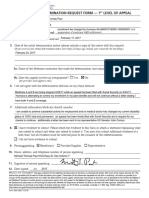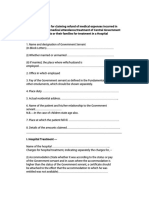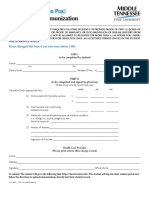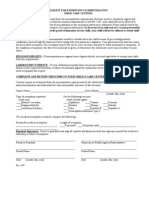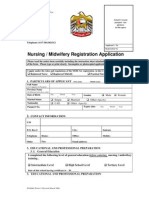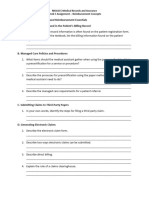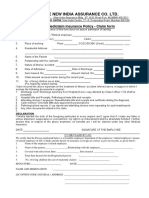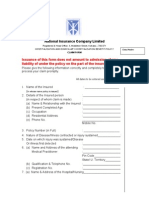SI.4 - FMLA Certification For Employee Serious Health Condition - 000000B106
SI.4 - FMLA Certification For Employee Serious Health Condition - 000000B106
Uploaded by
danisummers94Copyright:
Available Formats
SI.4 - FMLA Certification For Employee Serious Health Condition - 000000B106
SI.4 - FMLA Certification For Employee Serious Health Condition - 000000B106
Uploaded by
danisummers94Original Title
Copyright
Available Formats
Share this document
Did you find this document useful?
Is this content inappropriate?
Copyright:
Available Formats
SI.4 - FMLA Certification For Employee Serious Health Condition - 000000B106
SI.4 - FMLA Certification For Employee Serious Health Condition - 000000B106
Uploaded by
danisummers94Copyright:
Available Formats
Certification of Health Care Provider for
U.S. Department of Labor
Employee’s Serious Health Condition Wage and Hour Division
under the Family and Medical Leave Act
OMB Control Number: 1235-0003
Expires: 6/30/2023
The Family and Medical Leave Act (FMLA) provides that an employer may require an employee seeking FMLA pro-
tections because of a need for leave due to a serious health condition to submit a medical certification issued by the
employee’s health care provider. 29 U.S.C. §§ 2613, 2614(c)(3); 29 C.F.R. § 825.305. The employer must give the
employee at least 15 calendar days to provide the certification. If the employee fails to provide complete and suffi-
cient medical certification, his or her FMLA leave request may be denied. 29 C.F.R. § 825.313. Information about the
FMLA may be found on theWHD website at www.dol.gov/agencies/whd/fmla.
SECTION I – EMPLOYEE
This form asks the health care provider for the information necessary for a complete and sufficient medical certification,
which is set out at 29 C.F.R. § 825.306. Employers may not ask the employee to provide more information than al-
lowed under the FMLA regulations, 29 C.F.R. §§ 825.306-825.308. Additionally, a certification for FMLA leave to
bond with a healthy newborn child or a child placed for adoption or foster care may not be requested.
Your employer must generally maintain records and documents relating to medical information, medical certifications,
recertifications, or medical histories of employees created for FMLA purposes as confidential medical records in separate
files/records from the usual personnel files and in accordance with 29 C.F.R. § 1630.14(c)(1), if the Americans with
Disabilities Act applies, and in accordance with 29 C.F.R. § 1635.9, if the Genetic Information Nondiscrimination Act
applies.
:
(1) Employee Name: ______________________________ Employee ID______________________
First Middle Last
(2) Employer Name: ______________________________Date:__________________(mm/dd/yyyy)
(3) Employee's Job Title:______________________ Employee Provided Job Description (Is/Is not) attached.
SECTION II - HEALTH CARE PROVIDER
Please provide your contact information, complete all relevant parts of this Section, and sign the form. Your patient has
requested leave under the FMLA. The FMLA allows an employer to require that the employee submit a timely, complete,
and sufficient medical certification to support a request for FMLA leave due to the serious health condition of the
employee. For FMLA purposes, a “serious health condition” means an illness, injury, impairment, or physical or mental
condition that involves inpatient care or continuing treatment by a health care provider. For more information about the
definitions of a serious health condition under the FMLA, see chart of page 4.
You may, but are not required to, provide other appropriate medical facts including symptoms, diagnosis, or any regimen
of continuing treatment such as the use of specialized equipment. Please note that some state or local laws may not allow
disclosure of private medical information about the patient’s serious health condition, such as providing the diagnosis and/or
course of treatment.
Page 1 of 4 Form WH-380-E, Revised June 2020
Employee Name: ____________________________________________________________________________________________
Health Care Provider’s name: (Print) ____________________________________________________________________
Health Care Provider’s business address: ________________________________________________________________
Type of practice / Medical specialty: ___________________________________________________________________
Telephone: (___) ______________ Fax: (___) ______________ E-mail: _______________________________________
PART A: Medical Information
Limit your response to the medical condition(s) for which the employee is seeking FMLA leave. Your answers should be
your best estimate based upon your medical knowledge, experience, and examination of the patient. After completing
Part A, complete Part B to provide information about the amount of leave needed. Note: For FMLA purposes,
“incapacity” means the inability to work, attend school, or perform regular daily activities due to the condition, treatment
of the condition, or recovery from the condition. Do not provide information about genetic tests, as defined in 29 C.F.R. §
1635.3(f), genetic services, as defined in 29 C.F.R. § 1635.3(e), or the manifestation of disease or disorder in the employee’s
family members, 29 C.F.R. § 1635.3(b).
(1) State the approximate date the condition started or will start: ___________________________________ (mm/dd/yyyy)
(2) Provide your best estimate of how long the condition lasted or will last: ____________________________________
(3) Check the box(es) for the questions below, as applicable. For all box(es) checked, the amount of leave needed must be
provided in Part B.
Inpatient Care: The patient ( has been / is expected to be) admitted for an overnight stay in a hospital,
hospice, or residential medical care facility on the following date(s): ______________________________
Incapacity plus Treatment: (e.g. outpatient surgery, strep throat)
Due to the condition, the patient ( has been / is expected to be) incapacitated for more than three
consecutive, full calendar days from ______________ (mm/dd/yyyy) to _____________ (mm/dd/yyyy).
The patient ( was / will be) seen on the following date(s): _____________________________________
_______________________________________________________________________________________
The condition ( has / has not) also resulted in a course of continuing treatment under the supervision of a
health care provider (e.g. prescription medication (other than over-the-counter) or therapy requiring special equipment)
Pregnancy: The condition is pregnancy. List the expected delivery date: _______________ (mm/dd/yyyy).
Chronic Conditions: (e.g. asthma, migraine headaches) Due to the condition, it is medically necessary for the patient
to have treatment visits at least twice per year.
Permanent or Long Term Conditions: (e.g. Alzheimer’s, terminal stages of cancer) Due to the condition, incapacity
is permanent or long term and requires the continuing supervision of a health care provider (even if active
treatment is not being provided).
Conditions requiring Multiple Treatments: (e.g. chemotherapy treatments, restorative surgery) Due to the condition,
it is medically necessary for the patient to receive multiple treatments.
None of the above: If none of the above condition(s) were checked, (i.e., inpatient care, pregnancy)
no additional information is needed. Go to page 4 to sign and date the form.
Page 2 of 4 Form WH-380-E, Revised June 2020
Employee Name: ____________________________________________________________________________________________
(4) If needed, briefly describe other appropriate medical facts related to the condition(s) for which the employee seeks
FMLA leave.(e.g., use of nebulizer, dialysis) Please Note: If this form is being used to certify the need for leave under the
California Family Rights Act, California regulations prohibit the disclosure of the underlying diagnosis of the seri-
ous health condition involved without the consent of the patient.
___________________________________________________________________________________
___________________________________________________________________________________
PART B: Amount of Leave Needed
For the medical condition(s) checked in Part A, complete all that apply. Several questions seek a response as to the frequency
or duration of a condition, treatment, etc. Your answer should be your best estimate based upon your medical knowledge,
experience, and examination of the patient. Be as specific as you can; terms such as “lifetime,” “unknown,” or “indeterminate”
may not be sufficient to determine FMLA coverage.
(5) Due to the condition, the patient ( had / will have) planned medical treatment(s) (scheduled medical visits)
(e.g. psychotherapy, prenatal appointments) on the following date(s): ___________________________________________
_____________________________________________________________________________________________
(6) Due to the condition, the patient ( was / will be) referred to other health care provider(s) for evaluation or
treatment(s).
State the nature of such treatments: (e.g. cardiologist, physical therapy) ________________________________________
Provide your best estimate of the beginning date ________________ (mm/dd/yyyy) and end date ________________
(mm/dd/yyyy) for the treatment(s).
Provide your best estimate of the duration of the treatment(s), including any period(s) of recovery (e.g. 3 days/week)
____________________________________________________________________________________________
(7) Due to the condition, it is medically necessary for the employee to work a reduced schedule.
Provide your best estimate of the reduced schedule the employee is able to work. From ____________________
(mm/dd/yyyy) to _______________(mm/dd/yyyy) the employee is able to work: (e.g., 5 hours/day, up to 25 hours a week)
_______________________________________________________________________________________________________________
(8) Due to the condition, the patient ( was / will be) incapacitated for a continuous period of time, including any
time for treatment(s) and/or recovery.
Provide your best estimate of the beginning date ___________________ (mm/dd/yyyy) and end date
________________ (mm/dd/yyyy) for the period of incapacity.
(9) Due to the condition, it ( was / is / will be) medically necessary for the employee to be absent from work on
an intermittent basis (periodically), including for any episodes of incapacity i.e., episodic flare-ups. Provide your
best estimate of how often (frequency) and how long (duration) the episodes of incapacity will likely last.
Over the next 6 months, episodes of incapacity are estimated to occur ___________________________ times per
( day / week / month) and are likely to last approximately ______________ ( hours / days) per episode.
Page 3 of 4 Form WH-380-E, Revised June 2020
Employee Name: ____________________________________________________________________________________________
PART C: Essential Job Functions
If the employee's essential job functions or a job description is not provided, answer these questions based upon the em-
ployee’s own description of their essential job functions. An employee who must be absent from work to receive medical
treatment(s), such as scheduled medical visits, for a serious health condition is considered to be not able to perform the es-
sential job functions of the position during the absence for treatment(s).
(10) Due to the condition, the employee ( was not able / is not able / will not be able) to perform one or more
of the essential job function(s). Identify at least one essential job function the employee is not able to perform:
_____________________________________________________________________________________________
_____________________________________________________________________________________________
Signature of
Health Care Provider:_____________________________________________________________________Date:_______________________(mm/dd/yyyy)
Definitions of a Serious Health Condition (See 29 C.F.R. §§ 825.113-.115)
Inpatient Care
• An overnight stay in a hospital, hospice, or residential medical care facility.
• Inpatient care includes any period of incapacity or any subsequent treatment in connection with the overnight stay.
Continuing Treatment by a Health Care Provider (any one or more of the following)
Incapacity Plus Treatment: A period of incapacity of more than three consecutive, full calendar days, and any subsequent treatment
or period of incapacity relating to the same condition, that also involves either:
o Two or more in-person visits to a health care provider for treatment within 30 days of the first day of incapacity unless
extenuating circumstances exist. The first visit must be within seven days of the first day of incapacity; or,
o At least one in-person visit to a health care provider for treatment within seven days of the first day of incapacity, which
results in a regimen of continuing treatment under the supervision of the health care provider. For example, the health
provider might prescribe a course of prescription medication or therapy requiring special equipment.
Pregnancy: Any period of incapacity due to pregnancy or for prenatal care.
Chronic Conditions: Any period of incapacity due to or treatment for a chronic serious health condition, such as diabetes, asthma,
migraine headaches. A chronic serious health condition is one which requires visits to a health care provider (or nurse supervised by
the provider) at least twice a year and recurs over an extended period of time. A chronic condition may cause episodic rather than a
continuing period of incapacity.
Permanent or Long-term Conditions: A period of incapacity which is permanent or long-term due to a condition for which
treatment may not be effective, but which requires the continuing supervision of a health care provider, such as Alzheimer’s disease
or the terminal stages of cancer.
Conditions Requiring Multiple Treatments: Restorative surgery after an accident or other injury; or, a condition that would likely
result in a period of incapacity of more than three consecutive, full calendar days if the patient did not receive the treatment.
PAPERWORK REDUCTION ACT NOTICE AND PUBLIC BURDEN STATEMENT
If submitted, it is mandatory for employers to retain a copy of this disclosure in their records for three years. 29 U.S.C. § 2616; 29 C.F.R. § 825.500. Persons
are not required to respond to this collection of information unless it displays a currently valid OMB control number. The Department of Labor estimates
that it will take an average of 15 minutes for respondents to complete this collection of information, including the time for reviewing instructions, searching
existing data sources, gathering and maintaining the data needed, and completing and reviewing the collection of information. If you have any comments
regarding this burden estimate or any other aspect of this collection information, including suggestions for reducing this burden, send them to the
Administrator, Wage and Hour Division, U.S. Department of Labor, Room S-3502, 200 Constitution Avenue, N.W., Washington, D.C. 20210.
PLEASE SEND COMPLETED FORM TO THE BELOW ADDRESS OR FAX NUMBER.
Page 4 of 4 Form WH-380-E, Revised June 2020
You might also like
- ATLS Pretest AnswersDocument18 pagesATLS Pretest AnswersMohammed Saad92% (13)
- AMC Clinical Recalls - PAEDIATRICSDocument28 pagesAMC Clinical Recalls - PAEDIATRICSbreezingthru80% (5)
- Instructions: Certification of Health Care Provider: Family and Medical Leave ActDocument5 pagesInstructions: Certification of Health Care Provider: Family and Medical Leave ActMichelleNo ratings yet
- Sedgwick Logo - Certification of Health Care Provider For Family Member's Serious Health Condition (FMLA)Document4 pagesSedgwick Logo - Certification of Health Care Provider For Family Member's Serious Health Condition (FMLA)teamirNo ratings yet
- AM Cert Disability FMLA GLA 10981 PDFDocument5 pagesAM Cert Disability FMLA GLA 10981 PDFEsteven Michal Al-Merlin Wallace Ceelah El BeyNo ratings yet
- FMLA Blank FormDocument4 pagesFMLA Blank FormAndy WilsonNo ratings yet
- Medicaid AppealDocument15 pagesMedicaid Appealmtp7389No ratings yet
- Certification of Health Care ProviderDocument4 pagesCertification of Health Care ProviderDavidNo ratings yet
- Extension Request LetterpacketDocument6 pagesExtension Request LetterpacketSherif AhmedNo ratings yet
- Certification Employees Serious Health ConditionDocument4 pagesCertification Employees Serious Health ConditionAnika OkjeNo ratings yet
- PD Medical Certification PD 615ADocument3 pagesPD Medical Certification PD 615AAfif Fauzan MNo ratings yet
- Claims OutreachDocument5 pagesClaims OutreachthurmancomputersNo ratings yet
- Family and Medical LeaveDocument5 pagesFamily and Medical LeaveGeorge RizkNo ratings yet
- COHP FamilyDocument4 pagesCOHP FamilyAbigail Aracely Ochoa AlvaradoNo ratings yet
- Certification of Health Care Provider For Family MBRDocument4 pagesCertification of Health Care Provider For Family MBRapi-241312847No ratings yet
- FMLA Revised 12-09Document5 pagesFMLA Revised 12-09Jennifer RobertsNo ratings yet
- Revised FMLA Forms Feb. 2013Document24 pagesRevised FMLA Forms Feb. 2013Molly DiBiancaNo ratings yet
- WH 380 eDocument4 pagesWH 380 ePor Justica EN YumaNo ratings yet
- Health CareDocument1 pageHealth CareMikeNo ratings yet
- Part A Notice To Withhold For Health Care CoverageDocument10 pagesPart A Notice To Withhold For Health Care CoverageCasey Durrance MurphyNo ratings yet
- Request To Postpone Certification Direct 1585343446169 PDFDocument3 pagesRequest To Postpone Certification Direct 1585343446169 PDFMelvin Fernando Peralta SuazoNo ratings yet
- Sss 02Document2 pagesSss 02June CruzNo ratings yet
- SSS Form CLD-9NDocument2 pagesSSS Form CLD-9NCat LedesmaNo ratings yet
- On The WHD Website at WWW - Dol.gov/agencies/whd/fmlaDocument4 pagesOn The WHD Website at WWW - Dol.gov/agencies/whd/fmlaknackkayNo ratings yet
- Proforma For Claiming Refund of Medical Expenses - 1 - Split - 1Document5 pagesProforma For Claiming Refund of Medical Expenses - 1 - Split - 1Ajay SinglaNo ratings yet
- Claim FormDocument3 pagesClaim FormSumit ManglaniNo ratings yet
- VETERAN READINESS and EMPLOYMENT SERVICES Factsheet 2020Document10 pagesVETERAN READINESS and EMPLOYMENT SERVICES Factsheet 2020nkwelledNo ratings yet
- Fmla-Certification Employees Serious Health Condition 0Document3 pagesFmla-Certification Employees Serious Health Condition 076xzv4kk5vNo ratings yet
- Lesley Fugon FMLA Eligbility NoticeDocument4 pagesLesley Fugon FMLA Eligbility Noticebessy cedilloNo ratings yet
- COVID RTW Form (CAN)Document3 pagesCOVID RTW Form (CAN)A. MuyepaNo ratings yet
- Certification of Your Family Member's Serious Health Condition Form - July - 2023Document7 pagesCertification of Your Family Member's Serious Health Condition Form - July - 2023Athenagoras SaldivarNo ratings yet
- RTW ReleaseV2Document6 pagesRTW ReleaseV2ack.techoNo ratings yet
- 2 Hipaa Front Notices-Page 1 2-13Document1 page2 Hipaa Front Notices-Page 1 2-13api-214017719No ratings yet
- Peace Corps Mental Health Treatment Summary Form TG-510-3 (Initial Approval 08/2012)Document5 pagesPeace Corps Mental Health Treatment Summary Form TG-510-3 (Initial Approval 08/2012)Accessible Journal Media: Peace Corps DocumentsNo ratings yet
- Medical History and Evaluation FormDocument22 pagesMedical History and Evaluation FormJobelle Fernandez-SantosNo ratings yet
- FAMILY MEMBER Notice of Eligibility Rights & Resp Template (WH-381 Exp 6.2023)Document4 pagesFAMILY MEMBER Notice of Eligibility Rights & Resp Template (WH-381 Exp 6.2023)Alex DanielNo ratings yet
- HCPC- COFM CONTENIDODocument4 pagesHCPC- COFM CONTENIDOcabinas rositaNo ratings yet
- 5004o00000P8ZJHAA3 - 1655998080504L080 Decision EOHCSTDDenied EE 04259813Document15 pages5004o00000P8ZJHAA3 - 1655998080504L080 Decision EOHCSTDDenied EE 04259813Sarah Ann KhalifaNo ratings yet
- Varicella Immunization CertDocument2 pagesVaricella Immunization CertShaikahamedNo ratings yet
- Forms PensionersDocument15 pagesForms PensionersAnimesh DasNo ratings yet
- National Insurance Company LimitedDocument4 pagesNational Insurance Company Limitedkaransandesara777No ratings yet
- Certificate For Mediclaim AdmittedDocument2 pagesCertificate For Mediclaim AdmittedabhaykuhadofficialNo ratings yet
- AZ Request Exempt Immun Child CareDocument1 pageAZ Request Exempt Immun Child CareDonnaNo ratings yet
- Bsnlmrs FormsDocument5 pagesBsnlmrs FormsdurgendraNo ratings yet
- Release of InformationDocument2 pagesRelease of Informationxstn15No ratings yet
- Nursing and Midwifery Registration Application.. UaeDocument4 pagesNursing and Midwifery Registration Application.. UaeMadeleine Mae Garcia SalamatNo ratings yet
- Week 5 Assignment Worksheet 2Document3 pagesWeek 5 Assignment Worksheet 2camilia168No ratings yet
- Authorization Form For Researchers The Use and Disclosure of PHIDocument2 pagesAuthorization Form For Researchers The Use and Disclosure of PHImatiushynsNo ratings yet
- Mediclaim FormDocument1 pageMediclaim Formpicrush2pmNo ratings yet
- (IL) FMLA Certification Form Employee Condition Beatriz RuizDocument5 pages(IL) FMLA Certification Form Employee Condition Beatriz RuizBeatriz RuizNo ratings yet
- Annexure - C Medical Reimbursement Claim Form For Outdoor TreatmentDocument3 pagesAnnexure - C Medical Reimbursement Claim Form For Outdoor TreatmentPatiala BsnlNo ratings yet
- BCBSTX Halliburton Intl Claim FormDocument2 pagesBCBSTX Halliburton Intl Claim FormLoganBohannonNo ratings yet
- 451 Standard Authorization FormDocument3 pages451 Standard Authorization FormedzuckermanNo ratings yet
- National Inurance Company Limited - Claim FormDocument3 pagesNational Inurance Company Limited - Claim FormfuckyouprettyNo ratings yet
- WH 384Document4 pagesWH 384glenn johnstonNo ratings yet
- Emergency Sick PayDocument6 pagesEmergency Sick PayJenNo ratings yet
- Cross-Training: The Medical Assistant WorkbookFrom EverandCross-Training: The Medical Assistant WorkbookNo ratings yet
- Newman's Billing and Coding Technicians Study GuideFrom EverandNewman's Billing and Coding Technicians Study GuideRating: 4.5 out of 5 stars4.5/5 (2)
- Health Care Reform Act: Critical Tax and Insurance RamificationsFrom EverandHealth Care Reform Act: Critical Tax and Insurance RamificationsNo ratings yet
- Social Security / Medicare Handbook for Federal Employees and Retirees: All-New 4th EditionFrom EverandSocial Security / Medicare Handbook for Federal Employees and Retirees: All-New 4th EditionNo ratings yet
- Lower Limb Anatomy PBLDocument3 pagesLower Limb Anatomy PBLFrancesca vitaleNo ratings yet
- Preventive Health Care and Corporate Female Workforce: ABBDocument8 pagesPreventive Health Care and Corporate Female Workforce: ABBnusrat_ahmad5805No ratings yet
- Uhs Pathology & Microbiology McqsDocument83 pagesUhs Pathology & Microbiology Mcqshadiazahra2002No ratings yet
- Venofer AlgorithmDocument4 pagesVenofer AlgorithmjozaiaNo ratings yet
- Nursing Care of The High Risk Postpartal ClientDocument11 pagesNursing Care of The High Risk Postpartal ClientMarielle J GarciaNo ratings yet
- 18.131 - LINNA NUR AENI - Unit 11&12Document2 pages18.131 - LINNA NUR AENI - Unit 11&12Linna Nur AeniNo ratings yet
- TB and TyphoidDocument20 pagesTB and Typhoidaishaiqbal6789No ratings yet
- Hemoflagellates - Lecture Notes For Clinical Parasitology Hemoflagellates - Lecture Notes For Clinical ParasitologyDocument6 pagesHemoflagellates - Lecture Notes For Clinical Parasitology Hemoflagellates - Lecture Notes For Clinical ParasitologypearlsNo ratings yet
- Wa0021.Document16 pagesWa0021.troyganNo ratings yet
- 18 Diabetes MellitusDocument20 pages18 Diabetes MellitusjoseandrescuevasmolinaNo ratings yet
- Cardiac Tamponade 2Document23 pagesCardiac Tamponade 2Jethro Floyd QuintoNo ratings yet
- Complete - HH - Feb - 2022 1 91 Pages 1775 78Document7 pagesComplete - HH - Feb - 2022 1 91 Pages 1775 78satpreet singhNo ratings yet
- Hesi RN PediatricsDocument24 pagesHesi RN Pediatricsracquela_3100% (1)
- COCO OIL MTC - The Mystery of Autism Solved - Bruce FifeDocument6 pagesCOCO OIL MTC - The Mystery of Autism Solved - Bruce Fifemarmar6382100% (2)
- Braden ScaleDocument1 pageBraden ScaleANo ratings yet
- Antibiotic Stewardship Program (ASP) in Palliative Care: Antibiotics, To Give or Not To GiveDocument8 pagesAntibiotic Stewardship Program (ASP) in Palliative Care: Antibiotics, To Give or Not To GiveUriel EnriquezNo ratings yet
- Longrichglobal Retail or Maintenance BonusDocument1 pageLongrichglobal Retail or Maintenance BonusdxpfzbbcqvNo ratings yet
- 109 New Charm, CharmaidDocument2 pages109 New Charm, CharmaidAmit Kumar PandeyNo ratings yet
- Name - Perumal Sex: M - AgeDocument21 pagesName - Perumal Sex: M - AgedrpravalkNo ratings yet
- MetforminDocument2 pagesMetforminfrancis ian AnchetaNo ratings yet
- Thesis Topics On Total Knee ReplacementDocument5 pagesThesis Topics On Total Knee Replacementsheilaguyfargo100% (2)
- 3rd Newsletter FinalDocument14 pages3rd Newsletter FinalBhavish RamroopNo ratings yet
- PTM 5 Bhs Inggris, Lyfia 5FDocument2 pagesPTM 5 Bhs Inggris, Lyfia 5Flyfia zuliannaNo ratings yet
- MCQ of The DayDocument5 pagesMCQ of The DayAbialbon PaulNo ratings yet
- Physiology OSPEDocument18 pagesPhysiology OSPEminareeba57No ratings yet
- Chronic Transaminitis 07Document39 pagesChronic Transaminitis 07Jessica GarletsNo ratings yet
- Section Four - The Writing SectionDocument26 pagesSection Four - The Writing SectionHazel Vivian Soliz AlconzNo ratings yet
- Slide IBSDocument34 pagesSlide IBSRamadhian Galih PratamaNo ratings yet






